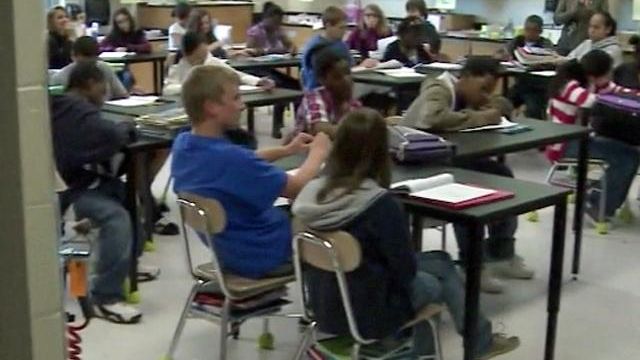Overcrowding highlights need for more Wake schools
The Wake County Board of Education's Policy Committee tabled further discussion on how student enrollment should be capped for the next school year, saying the issue is further proof that the board needs to work with the county leaders on a bond referendum to build schools.
Posted — UpdatedAbout one of three schools in Wake County is over capacity, and the school system has estimated that it needs to build about three schools a year to accommodate the growing student population.
In the short term, school leaders have proposed "caps" on enrollment at specific, desirable schools that would maintain the size of the student body, forcing any new students who move into a school’s traditional geographical draw to go elsewhere.
"We have not developed a strategy to make sure we're building capacity to meet the growth of Wake County," committee Chairman Jim Martin said. "We're going to have to work with commissioners. This isn't a Republican-Democrat issue. This isn't a liberal-conservative issue. This is people moving to Wake County. Students need to go somewhere. If we don't build schools, we'll have more conversations about capping."
But County Commission Chairman Paul Coble has put off any discussion about a potential $1 billion school construction bond after the school board's controversial and politically divisive votes this summer to change the three-year student assignment plan and to fire former Superintendent Tony Tata.
Coble said he wants to see the board prove that it can work together on a new assignment plan, as well as other initiatives, before even considering a school bond.
Under a proposed student assignment plan for the 2013-14 school year – a stop-gap measure until the board can develop a new plan for the 2014-15 school year – about three dozen schools face enrollment caps, which could force children to schools as far as 14 miles away from their homes.
"The issue will be with newcomers and transfer students from charter or private schools," school board member Christine Kushner said. "So we have to be real thoughtful."
Although the assignment proposal would reassign fewer than 1,500 students, capping schools could affect where a lot more go.
How many is unclear.
The school system gets about 7,000 transfer requests every year. In addition, an estimated 3,000 to 5,000 students move into the district each year.
School board members admit that capping a school to new students, while sometimes necessary, is not the best way to handle growth management.
"It's not a good practice," Martin said. "It's not something we want to do long-term."
One possible solution for next year is different levels of capping to help ease overcrowding.
For example, the system might reserve seats in a crowded school for students who live in the base-assignment area, but it would close enrollment to others students.
"So, when we see a school at 105 percent capacity, maybe we sound the alarms then and say, 'OK, we really can't allow a lot of people to come in due to various reasons, like transfers, etc., but, if you happen to live in the school base area, we’ve still got room for a few more,'" board member John Tedesco said.
It's a complex issue, he added, with 169 schools and about 150,000 students.
"We just want to make sure the rules are clear to the public and clear as to how we manage who and where gets capped," he said.
• Credits
Copyright 2024 by Capitol Broadcasting Company. All rights reserved. This material may not be published, broadcast, rewritten or redistributed.






